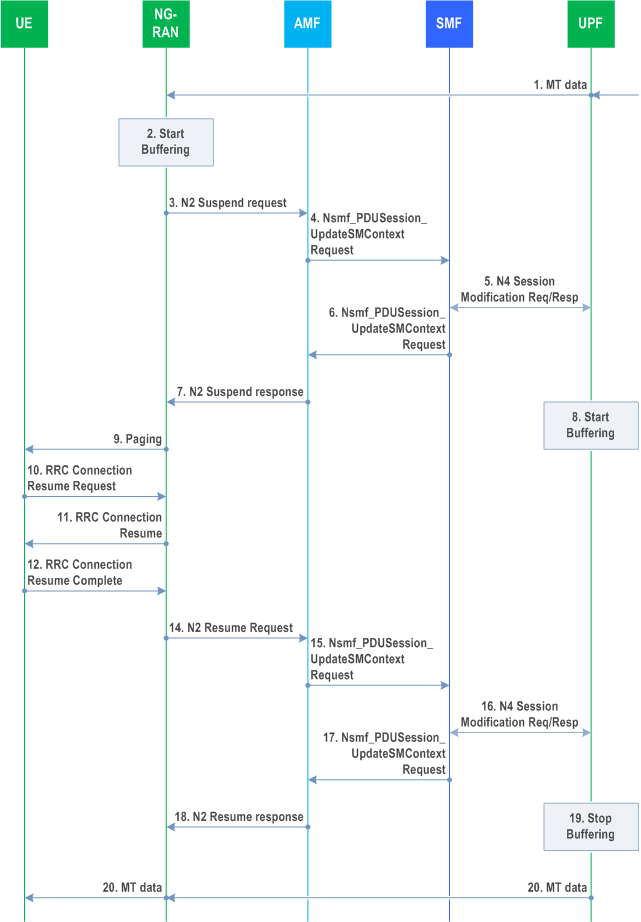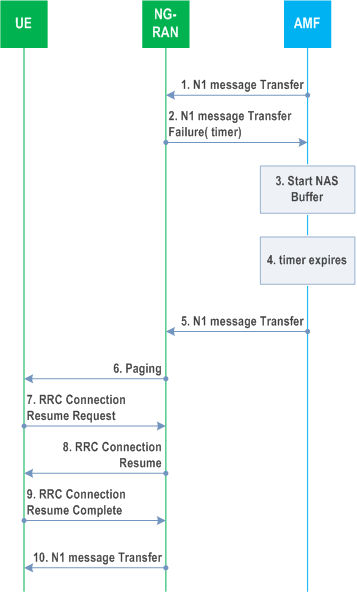Content for TR 23.700-68 Word version: 18.1.0
6.5 Solution #5: Enabling UPF buffering per NG-RAN request for UE in RRC_Inactive state with long eDRX cycle
6.5.1 Description
6.5.2 Procedures
6.5.2.1 MT data handling of UE with long eDRX in RRC_Inactive state
6.5.2.2 MT N1 message handling of UE with long eDRX in RRC_Inactive state
6.5.3 Impacts on services, entities and interfaces
...
...
6.5 Solution #5: Enabling UPF buffering per NG-RAN request for UE in RRC_Inactive state with long eDRX cycle p. 23
6.5.1 Description p. 23
This solution resolves Key Issue #1.
In this solution, after the UE enters into RRC_inactive state with long eDRX cycle, and when the NG-RAN receives MT data over the N3 tunnel, the NG-RAN buffers the MT data and sends a suspend indication to the network. When the network receives the suspend indication it starts the MT data buffering in the UPF. When the UE becomes reachable again, the NG-RAN triggers the paging procedure and the UE enters into RRC_connected state. The NG-RAN then forwards the buffered MT data to the UE. If the NG-RAN has sent the suspend indication to the network, it sends resume indication to the network to disable the UPF buffering and start the delivery of MT data to the NG-RAN.
When the NG-RAN node receives N1 NAS message and it determines that it is not possible to transfer the N1 NAS message to the UE before the NAS retransmission timer expires, it sends N1 NAS Message Transfer Failure message to the AMF, with a cause value that the UE is temporarily not reachable and an expected waiting time value. The AMF starts a timer. Before the timer expires the AMF stops sending any further N1 NAS message to the NG-RAN. After the timer expires, the AMF starts to send the N1 NAS message to the NG-RAN and the NG-RAN triggers the paging procedure.
When the UE becomes RRC_connected state due to any MO data or signalling, the NG-RAN sends resume indication to the network to enable the N1 message delivery and disable the UPF buffering. Then the network starts to transfer the buffered MT data or N1 NAS message to the NG-RAN.
When the UE moves outside of the RNA it triggers RNA update and the data buffered in the last serving NG-RAN node can be forwarded to the target NG-RAN node.
6.5.2 Procedures p. 24
6.5.2.1 MT data handling of UE with long eDRX in RRC_Inactive state p. 24

Step 1.
The MT data is sent to NG-RAN from the UPF over the N3 user plane connection.
Step 2.
Since the NG-RAN knows the UE is in eDRX cycle and not reachable for paging, it starts to buffer the downlink data.
Step 3.
The NG-RAN may determine to enabler the MT data buffering in the UPF (e.g. when the remaining UE unreachable time is long enough or when the RAN buffer will be overflown), it sends N2 Suspend Request to AMF, including an indication to enable the MT data buffer in UPF and keep the UE in CM-CONNECTED state. The NG-RAN may also provide an Expected Waiting Time so the UPF can determine the buffer time.
Step 4.
The AMF sends Nsmf_PDUSession_UpdateSMContext request to the SMF to enable MT data buffering in UPF. The AMF provides the Expected Waiting Time to the SMF. The AMF keeps the UE in the CM-CONNECTED state, i.e. keeping the N1 and N2 connection in the UE context.
Step 5.
The SMF sends N4 Session Modification procedure to enable the MT data buffering in UPF. The UPF starts to buffer further MT data while still keeping the N3 tunnel towards the NG-RAN, i.e. the UPF doesn't remove the N3 GTP-U tunnel endpoint identity in NG-RAN. The SMF use the Expected Waiting Time to set the buffer timer in the UPF.
Step 6.
The SMF sends Nsmf_PDUSession_UpdateSMContext Response to AMF.
Step 7.
The AMF sends N2 Suspend Response to the NG-RAN.
Step 8.
After step 5, the UPF starts to buffer further downlink data.
Step 9.
When the eDRX timer expires, the NG-RAN determines that the UE is reachable again. If there is any downlink data buffered in the NG-RAN, the NG-RAN sends paging request in all the cells of the RNA (RAN Notification Area).
Step 10.
When the UE receives paging request, it sends RRC Connection Resume request to the NG-RAN to resume the RRC connection.
Step 11.
The NG-RAN sends RRC Connection Resume to the UE to resume the RRC connection.
Step 12.
The UE sends RRC Connection Resume Complete to the NG-RAN. After this step, the RRC connection between the UE and NG-RAN is resumed.
Step 13.
The NG-RAN sends the buffered MT data to UE via the user plane connection between UE and NG-RAN.
Step 14.
If the NG-RAN has sent N2 Suspend Request to AMF in step 3, it sends N2 Resume Request to AMF to enable the MT data transfer over N3 user plane connection.
Step 15.
The AMF sends Nsmf_PDUSession_UpdateSMContext request to the SMF to enable MT data transferring.
Step 16.
The SMF sends N4 Session Modification procedure to enable the MT data transferring in UPF.
Step 17.
The SMF sends Nsmf_PDUSession_UpdateSMContext Response to AMF.
Step 18.
The AMF sends N2 Suspend Response to the NG-RAN.
Step 19.
The UPF stops the MT data buffering.
Step 20.
The UPF sends the buffered MT data and further received MT data towards the NG-RAN via the N3 user plane connection between the NG-RAN and UPF.
6.5.2.2 MT N1 message handling of UE with long eDRX in RRC_Inactive state p. 25

Step 1.
The AMF determines to send N1 NAS message to the UE, so it sends N1 Message Transfer to the NG-RAN.
Step 2.
Since the NG-RAN knows the UE is in eDRX cycle and based on the remaining unreachable time, the UE is not reachable before the NAS retransmission timer expires, the NG-RAN rejects the N1 Message Transfer, with a cause value indicating that the UE is temporarily not reachable. The NG-RAN may also include an Expected Waiting Time in the rejection message.
Step 3.
Based on implementation the AMF may reject the request which triggers the N1 message. The rejection message may include an Expected Waiting Time received from the NG-RAN.
Step 4.
The AMF starts a timer according to the received Expected Waiting Time from NG-RAN. Before the timer expires the AMF doesn't try to deliver any further N1 NAS message to the NG-RAN. The AMF keeps the UE in the CM-CONNECTED state, i.e. keeping the N1 and N2 connection in the UE context.
Step 5.
When the timer expires, and the AMF receives further request for N1 NAS message delivery it sends N1 Message Transfer to the NG-RAN.
Step 6.
The NG-RAN determines that the UE is reachable and it sends Paging request in the RNA.
Step 7.
When the UE receives paging request, it sends RRC Connection Resume request to the NG-RAN to resume the RRC connection.
Step 8.
The NG-RAN sends RRC Connection Resume to the UE.
Step 9.
The UE sends RRC Connection Resume Complete to the NG-RAN. After this step, the RRC connection between the UE and NG-RAN is resumed.
Step 10.
The NG-RAN sends the N1 NAS message to the UE over the RRC connection.
6.5.3 Impacts on services, entities and interfaces p. 26
NG-RAN, when the UE is in RRC_Inactive state:
- After receiving and buffering the MT data, the NG-RAN sends suspend indication to AMF to enable the UPF buffering.
- Reject the N1 message transfer with cause value and expected waiting time value.
- When the UE becomes in RRC_connected state, the NG-RAN sends resume indication to AMF to disable the UPF buffering and enable the delivery of MT data and MT N1 message.
- Handling of suspend indication and resume indication from NG-RAN.
- Handling of N1 message transfer failure.
- Handling of suspend indication and resume indication from AMF.
- Enable/Disable the UPF buffering while keeping the N3 tunnel.